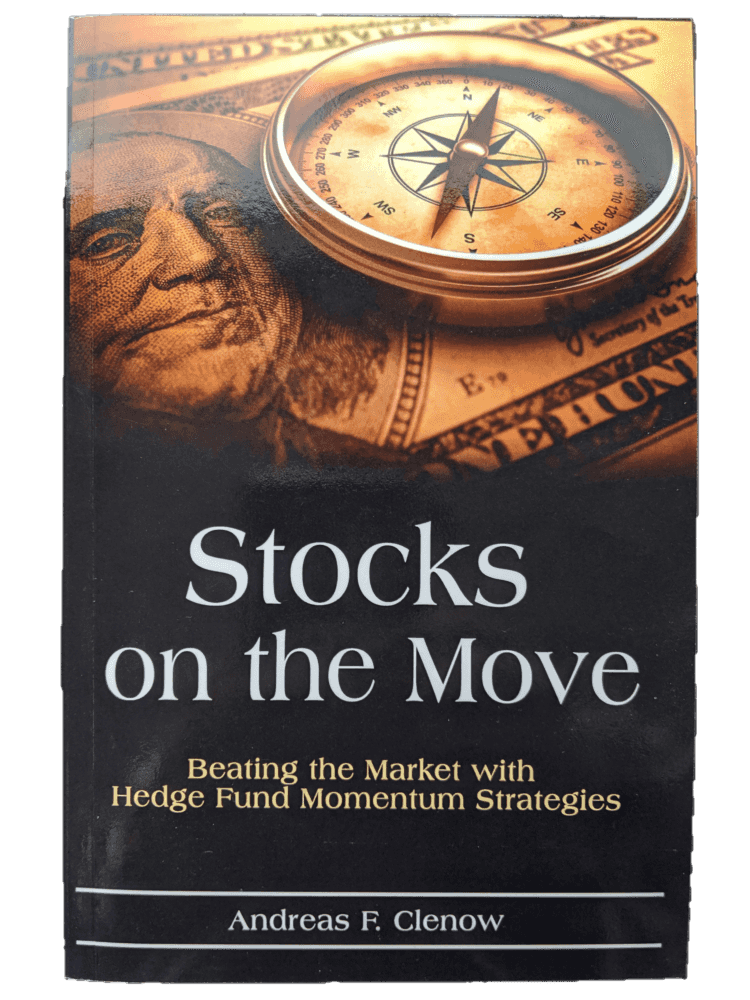Clenow's Stocks on the Move
Similar Strategies
- Objective: aggressive growth
- Type: momentum strategy
- Invests in: individual stocks from the S&P 500
- Rebalancing schedule: weekly
- Taxation: 90% short-term capital gains
- Minimum account size: $30,000
Andreas F. Clenow founded and managed multiple hedge funds, and is currently Chief Investment Officer of ACIES Asset Management AG in Switzerland. Clenow published his Stocks on the Move strategy in 2015 in his book carrying the same name.
Clenow's Stocks on the Move strategy aims to beat the S&P 500 at lower volatility. To do so, Clenow's strategy trades individual stocks from the S&P 500. The strategy selects the stocks based based on volatility-adjusted momentum and uses a naive risk-parity approach for position sizing.
Stocks on the Move has moderate maintenance requirements, as it rebalances its positions once per week.
Strategy Rules
The operation of Stocks on the Move can be summarized as follows:
- trade all S&P 500 stocks
- rebalance once per week (on Wednesdays)
- disqualify stocks trading below their 100-day moving average
- disqualify stocks that made any single-day moves exceeding 15% in the past 90 days
- rank stocks by their volatility-adjusted momentum, calculated as the product of slope and R2 of a 90-day logarithmic regression
- only open new positions, if the S&P 500 is trading above its 200-day moving average
- use fixed-fractional position sizing, based on the 20-day average trading range
We recommend reading Clenow's book Stocks on the Move for full detail regarding these rules and the rationale behind them. For those interested in diving deeper into the strategy, we also suggest checking the C# source code in the TuringTrader.org open-source repository.
Our version of the Stocks on the Move strategy matches the book closely. However, we slightly simplified the rebalancing schedule: The book selects portfolio components every week and adjusts position sizes only every other week. In an attempt to make the procedure more approachable, our implementation of the strategy adjusts position sizes every week. In our testing, this change had only little influence on the performance.
As the strategy invests in those large-cap stocks with the strongest momentum, investors will find constant positive coverage of their stocks in the news. This psychological aspect makes it easier to develop trust in the strategy, and follow it without second-guessing.
We like Clenow’s naive risk-parity approach a lot, which aligns with our view that in times of stress all S&P 500 stocks become highly correlated. However, we see potential shortcomings in the strategy’s money-management. In times of high market volatility, the strategy diversifies into more positions, effectively taking on additional risk. Further, in times of low market volatility, Stocks on the Move might concentrate risk in too few positions.
We made proprietary modifications to the strategy to remedy these shortcomings. Interested readers should refer to TuringTrader's Stocks on the Loose and Stocks on a Stroll strategies.
Diversification
Clenow’s strategy typically holds between 10 and 30 stocks simultaneously. With that, the strategy is well diversified in terms of U.S. large-cap stocks. However, this represents only a single asset class, and with that Stocks on the Move has a tail risk similar to that of holding the S&P 500 index.
Returns & Volatility
Stocks on the Move beats the S&P 500 in many years. Returns are stable, with typical volatility well below the S&P.
The strategy has handled the 2008 recession very well. In addition, it has handled the difficult markets of 2015 and 2018 better than most other momentum strategies.
The Monte-Carlo simulation shows how Stocks on the Move creates only little upside, while at the same time offering a meaningful reduction of downside risk. As a result, the strategy offers better risk-adjusted returns than the index.
However, we feel that the Stocks on the Move's too simplistic money-management hides the strategy's true potential.
Account & Tax Considerations
Clenow’s strategy trades frequently and will trigger many taxable events. The chart above shows that investors should expect all capital gains to be short-term. Therefore, the strategy will work best in tax-deferred accounts. With returns about on-par with the S&P 500, the strategy creates only little value in taxed accounts.
Because the strategy holds up to 30 stocks simultaneously, it requires no less than $30,000 to function correctly.
Summary
Performance
This table shows the portfolio's key performance metrics over the course of the simulation:
The following chart shows the portfolio's historical performance and drawdowns, compared to their benchmark, throughout the simulation:
Download as CSV
This chart shows the portfolio's annual returns:
The following charts show the Monte-Carlo simulation of returns and drawdowns, the portfolios 12-months rolling returns, and how the portfolio is tracking to its benchmark:
Asset Allocation
The portfolio last required rebalancing after the exchanges closed on . Due to fluctuations in asset prices, the exact allocations vary daily, even when no rebalancing occurred. The current asset allocation is as follows:
| Symbol | Name | Allocation |
|---|---|---|
| … | … | |
| … | … | |
| … | … |


